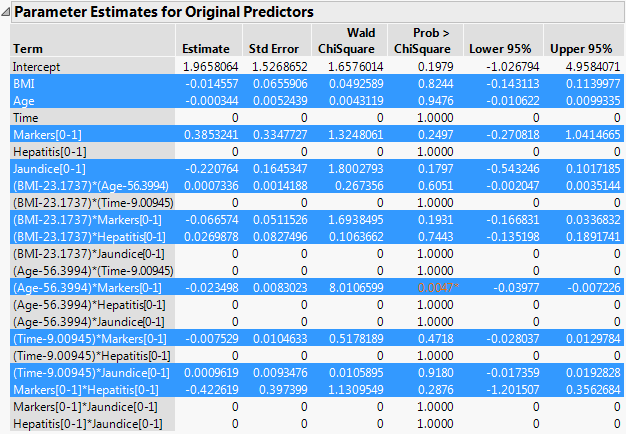The Liver Cancer.jmp sample data table contains liver cancer Node Count values for 136 patients. It also includes measurements on six potentially related variables: BMI, Age, Time, Markers, Hepatitis, and Jaundice. These columns are described in Column Notes in the data table.
This example develops a prediction model for Node Count using the six predictors. Node Count is modeled using a Poisson distribution.
|
1.
|
|
2.
|
Select Analyze > Fit Model.
|
|
3.
|
|
4.
|
This adds all terms up to degree 2 (the default in the Degree box) to the model.
|
5.
|
|
6.
|
From the Personality list, select Generalized Regression.
|
|
7.
|
From the Distribution list, select Poisson.
|
|
8.
|
Click Run.
|
|
9.
|
Click Go.
|
|
10.
|
Click the red triangle next to Adaptive Lasso with Validation Column and select Select Nonzero Terms.
|
The Solution Path is shown in Figure 7.1. The paths for terms that have nonzero coefficients are highlighted. Think of the solution paths as moving from right to left across the plot, as the solutions shrink farther from the MLE. A number of terms have paths that shrink them to zero fairly early.
The Parameter Estimates for Original Predictors report (Figure 7.2) shows the parameter estimates for the uncentered and unscaled data. The 11 terms with nonzero parameter estimates are highlighted. These include interaction effects. In the data table, all six predictor columns are selected because every predictor column appears in a term that has a nonzero coefficient.
In the Effect Tests report, the 10 effects with zero coefficient estimates are designated as Removed. The Effect Tests report indicates that only one effect is significant at the 0.05 level: the Age*Markers interaction.
|
11.
|
Click on the row for (Age - 56.3994)*Markers[0-1] in the Parameter Estimates for Original Predictors report.
|
This action highlights that effect’s path in the Solution Path Plot and selects the columns Age and Markers in the data table.
|
12.
|
Click the red triangle next to Adaptive Lasso with Validation Column and select Save Columns > Save Prediction Formula and Save Columns > Save Variance Formula.
|
|
13.
|
Right-click either column heading and select Formula to view the formula. Alternatively, click on the plus sign to the right of the column name in the Columns panel.
|
The prediction formula in the Save Prediction Formula column applies the exponential function to the estimated linear part of the model. The prediction variance formula in Node Count Variance is given by the identical formula, because the variance of a Poisson distribution equals its mean.

